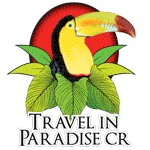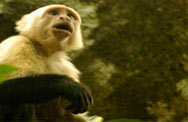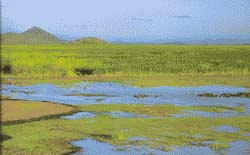|
|
Palo Verde National Park
Dr. Rafael Lucas Rodríguez Caballero National Wildlife Refuge: What were formerly a national park and an adjacent national wildlife refuge are now managed as one large conservation unit that also includes the nearby Lomas Barbudal Biological Reserve. The Palo Verde sector comprises 13,058 ha. of varied habitats in the lower Tempisque River basin. Of the mangrove forests, dry forests, evergreen forests, old pasture land, and other habitats protected here, the habitat that is primarily responsible for the creation of the park and refuge lands is the extensive marsh area that provides an important wintering ground to many species of migrant North American waterfowl, as well as resident tropical species such as the Jabiru, the largest stork in the New World.
The marshes fill up with rain and occasional flood waters during the wet season. As the dry season progresses, the wetlands are reduced to scattered ponds and puddles at which large concentrations of waterfowl gather. Perhaps the most numerous species are the resident Black-bellied Whistling-Ducks and Northern Jacanas.
Palo Verde also provides vital nesting sites for many native species of birds, the most notable is a small island of mangroves in the middle of the Tempisque River known as Isla Pájaros, or Bird Island (not to be confused with another Isla Pájaros located in the Gulf of Nicoya near Punta Morales). Cattle Egrets, Roseate Spoonbills, Wood Storks, Anhingas, Great Egrets, and Black-crowned Night-Herons all use this island for breeding.
During the dry season, when many of the forest trees are leafless and water is at a premium, wildlife is often quite easily seen, especially if you find a water source and wait quietly for the animals to come by for a drink. Commonly seen mammals at Palo Verde include Collared Peccaries, White-throated Capuchin Monkeys, Howler Monkeys, White-nosed Coatis, White-tailed Deer, and Variegated Squirrels. During the wet season, mosquitoes are quite easily seen.
Getting there: From the intersection at the town of Bagaces on the PanAmerican Highway, turn west onto a gravel road that leads 19 km. to the entrance station (there are several turns en route, but the way to the park should be posted). From the entrance it is another 9 km. to the administration at the old Hacienda Palo Verde.
Entering by boat from the Tempisque River is also possible. Six kilometers up river from the village of Puerto Humo (where boats can be hired), there is a rustic dock at a spot known as Puerto Chamorro, 2 km. beyond the administrative area via a dirt road. Further up river from Puerto Chamorro, the Tempisque becomes very sinuous and the riverside vegetation takes on a truly jungly aspect, adding to the sensation of being in a Tarzan movie are the numerous American Crocodiles that slide into the water from the banks as a boat approaches.
Climate: Palo Verde is one of the hottest and driest parts of Costa Rica. The dry season extends from mid-November through mid-May most years, but does vary somewhat. If visiting during the dry season, be sure to drink plenty of liquid and try to avoid staying in direct sunshine for very long so as to eliminate the risk of heat exhaustion, or worse, heat stroke.
History: Geologically, the lower Tempisque River basin is unique in Costa Rica since the surrounding hills are of limestone and not volcanic rock. This material was originally formed by corals some 40 to 60 million years ago when the area was part of the ocean floor. Subsequent shifting of the continental plates has caused these low hills to rise to their present heights and also changed the course of the Tempisque River that once flowed directly out to sea in the general area of what is now the Tamarindo National Wildlife Refuge.
In the past century, extensive cattle ranching was the principal agricultural activity in the area that is now Palo Verde National Park (in the greater sense). The haciendas were characterized by having large tracts of land on which the cattle roamed and grazed freely with little care other than periodic deparasitizing or being rounded up and driven to market. This meant that the natural forests suffered relatively minor disturbance and the human population level stayed quite low, since just a few men could handle a large herd. Thus, wildlife fortunately is still fairly abundant throughout the park and much of the original natural habitat has been preserved. |
Travel Tips:
FAQs: You might be wondering too.
About CR
About weather
What to pack: click here to get ideas on what you really need to bring along.
What to wear: click here to get ideas on what to wear. Avoid mistaken clothes.
Our Specialty Your Best Travel, vacations Family Trips, Honeymoons, Educational Trip, Escorted Trip.
Honeymoon Beyond a romantic setting, a honeymoon in Paradise is a magical experience.
Family oriented Trip
: Is about experiencing fascinating cultures, family adventures, family tours, quality time together.
Incentives travels: Creative ideas, consulting services for a theme party or special event.
|











